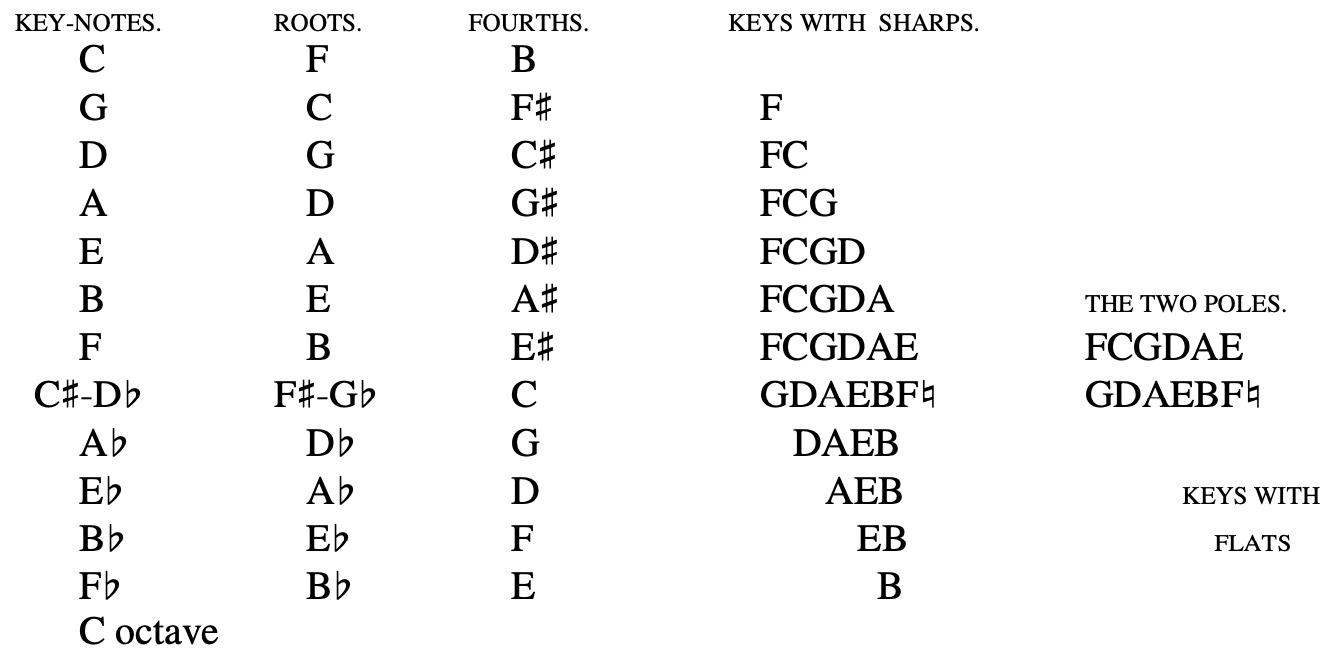Hughes
The key-note C sounding from within itself its six tones to and fro in trinities, the tones written as notes in musical clef
—The trinities hereafter termed primaries and secondaries
—The seven of each of the twelve key notes developing their tones
—The order in which the tones meet, avoiding consecutive fifths
—Dissonance is not opposition or separation
—The use of the chasms and double tones is seen
—The isolated fourths sound the twelve notes
—Each double tone developes only one perfect major harmony, with the exception of F#-G?; F# as the key-tone sounds F? as E#, and G? as the key-tone sounds B? as C?
—The primaries of the twelve key-notes are shown to sound the same tones as the secondaries of each third harmony below, but in a different order
—All harmonies are linked into each other, . 23 [Harmonies of Tones and Colours, Table of Contents2 - Harmonies]
The modulating gamut
—One series of the twelve keys meeting by fifths through seven octaves
—Keys not mingled
—A table of the key-notes and their trinities thus meeting
—The fourths not isolated
—The table of the twelve scales meeting by fifths
—The twelve keys, trinities, scales, and chords thus meeting are written in musical clef
—The twelve meeting through seven circles, each circle representing the eighteen tones
—The keys of C and G meeting, coloured
—Retrospection of the various major developments, . . . . 29 [Harmonies of Tones and Colours, Table of Contents3 - Harmonies]
THE twelve keys have been traced following each other seven times through seven octaves, the keys mingled, the thirteenth note being the octave, and becoming first of each rising twelve. Thus developing, the seven notes of each eighth key were complementary pairs, with the seven notes of each eighth key below, and one series of the twelve keys may be traced, all meeting in succession, not mingled. When the notes not required for each of the twelve thus meeting are kept under, the eighths of the twelve all meet by fifths, and as before, in succession, each key increases by one sharp, the keys with flats following, each decreasing by one flat; after this, the octave of the first C would follow and begin a higher series. It is most interesting to trace the fourths, no longer isolated, but meeting each other, having risen through the progression of the keys to higher harmonies. In the seven of C, B is the isolated fourth, meeting F#, the isolated fourth in the key of G, and so on. Each ascending key-note becomes the root of the fifth key-note higher; thus C becomes the root of G, &c. [Harmonies of Tones and Colours, Diagram VII - The Modulating Gamut of the Twelve Keys1, page 29]

See Also
